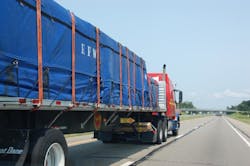The for-hire truck tonnage index compiled by the American Trucking Associations (ATA) jumped 2.9% in January, after falling 4.3% last December; a sign that “the freight economy is starting to show some signs of life,” according to Bob Costello, chief economist for the trade group.
Compared with January 2016, the index increased 2.6%, he added, with tonnage up 2.5% for all of 2016 versus 2015.
“Looking ahead, the most recent positive sign for truck tonnage is the large drop in the inventory-to-sales ratio during December. The decrease put inventories throughout the supply chain, relative to sales, to the lowest level in two years,” Costello noted in a statement.
“There is no doubt that the inventory glut was a drag on truck freight volumes last year,” he emphasized. “Hopefully, the ups and downs in truck tonnage during 2016 will not be as pronounced in 2017.”
However, John Larkin, managing director and head of transportation capital markets research for Stifel Capital Markets, recently noted that the uptick in freight volumes is not being felt across the board in trucking right now.
“Freight volumes are much better for a few carriers, slightly better for quite a few carriers, and are flat as a pancake for still others,” he explained in a research note issued following the firm’s annual conference in Florida last week.“Flatbed, open-deck, un-sided, and/or specialized truckload carriers seemed to have witnessed the biggest of the definitive upticks in volume,” Larkin said. “Volumes seem to be definitively bouncing off the bottom."
However, dry van demand in February “cooled off disappointingly,” he pointed out, though the LTL sector witnesses some “definitive improvement” in demand.
Larkin also said most motor carriers remained “disciplined” with respect to capacity additions, after many downsized their fleets in 2016 – downsizing done in an attempt to maintain equipment utilization and driver pay at acceptable levels in a “soft” freight demand environment
“Now, a few operators are taking advantage of their strong balance sheets and leverage with needy manufacturers to modestly increase the size of their fleets in preparation for the coming of more favorable freight conditions,” he explained.
“Most are reducing their average fleet age in order to improve fuel efficiency and increase driver satisfaction, while keeping maintenance streamlined and efficient,” Larkin said.
Pricing in the trucking sector appears to have “bottomed” and in some cases is improving after a rough experience in 2016, he added, though evidence of “definitive” freight rate increases remains scarce even as many fleets “expressed optimism” that a tightening supply/demand dynamic will improve pricing more dramatically later in 2017.”
About the Author
Sean Kilcarr
Editor in Chief
Sean Kilcarr is a former longtime FleetOwner senior editor who wrote for the publication from 2000 to 2018. He served as editor-in-chief from 2017 to 2018.

